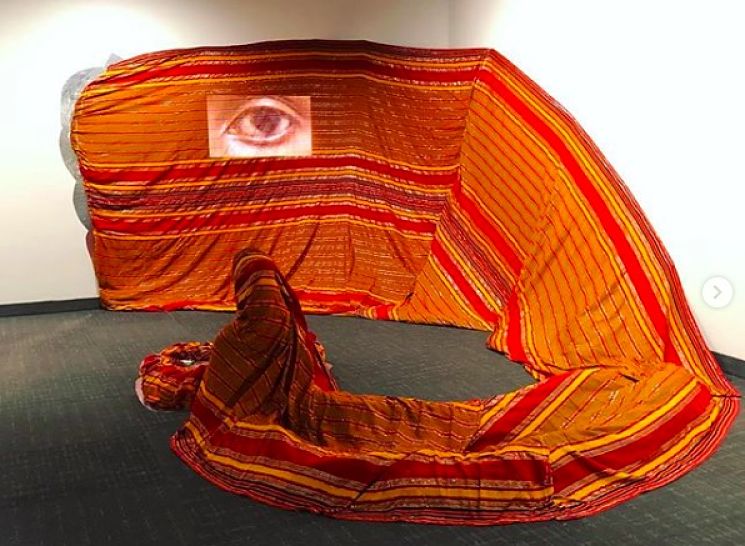Since Donald Trump took office as president in January of 2017, the United States has seen various iterations of the “Muslim ban,” with the last version ratified by the Supreme Court. We have since seen children and parents seeking asylum on our Southern border cruelly separated and put into cages, and we’ve seen a terrifying uptick in white supremacists unafraid to take their views and even their violence out into the open.
In a world that’s shown itself to be increasingly intolerant, we need a diversity of voices to counteract hateful rhetoric. One such voice is Twin Cities-based Somali playwright, performer, and visual artist Ifrah Mansour. A humble, quiet person, Mansour has a creative spirit that manifests itself in theatre, sculpture, and other artistic realms. Through her art she does the hard work of battling the prejudices and misunderstandings people have about people from Somalia, as well as people who are Muslim.
Her play How to Have Fun in a Civil War shares Mansour’s experiences as a young child during the still ongoing Somali Civil War. The piece is whimsical and humorous, as well as heartwarming. Mansour wrote the first iteration back in 2014, when she was asked to present something about Somalia for a gig in North Dakota. The next year she performed it at the Minnesota State Fair, at which point it was still just a 10-minute play. Since then she has expanded it into a full-length play, which she has presented at the Children’s Theatre Company, at the Guthrie Theatre’s Dowling Studio, and most recently on a tour around Minnesota, including to small cities with high immigrant populations, including Willmar, Rochester, St. Cloud, as well as at the Minnesota History Center in St. Paul.
Mansour said she’s been interested to see how different generations of Somalis experience the play. For survivors of the civil war, there’s a lot of trauma that comes up in witnessing the story, whereas second generation college students born after the war have expressed a need and a desire to know more the stories of what happened to their parents and grandparents.
“There was a beautiful intergenerational conversation that was happening,” Mansour says. “We are all carrying the trauma, whether we know it or not, whether we can name it or not. It is affecting us in our day-to-day lives.”
Born in Saudi Arabia, Mansour was living in Somalia with her family when civil war broke out in 1991. Her family was forced to leave the capital city of Mogadishu without so much as their passports for their journey. Her play takes a child’s-eye view of the experience of living through a war, capturing a sense of whimsy and beauty even in the midst of strife. Because when you’re a kid, you still like to play and find the joy of things, even if there happens to be a war going on.
In the play Mansour plays herself as a young child. Her hair streams every which way, and she’s accompanied by a giant puppet made of red and gold fabric, symbolizing her grandma. Mansour’s play asks the audience to listen with their hearts rather than their brains.
She notes that it’s not intended as a history lesson, an expectation she pushes against in post-show discussions. “I used to hate when people ask me about the history of the civil war,” Mansour said. “It might be a safety thing. If you get emotional with a bunch of strangers, it makes people uncomfortable. They want to go back to a comfortable place, based on facts.”
Mansour hopes to decondition people away from always grasping for political, historical, and social context, and instead get them to face the people in the room. “The only authentic way of learning about the Somali experience is literally from the source—that is the individuals,” Mansour says.

For Somali folks that have come to the show, a healing happens. “She did an incredible job shedding light on the experience,” said Salmah Hussein, a high school social worker in Minneapolis who participated in the talkback discussion after the performance at Minnesota History Center. She added, “I believe that we fight hate by being in relationship and being in space with one another.”
Chunu Shukri, who also participated in the panel discussion at the History Center, said Mansour does a good job delivering the message that refugees and immigrants are only trying to survive. “This is what happened to us—we are not here to take anything away from you,” she said. “We are here to survive just like anyone who is traumatized.”
While Mansour’s work speaks specifically from and to the Somali refugee experience, she also hopes for it to have broader resonance for other communities who have experienced forced migration, including the so-called “migrant caravan.”
“We have such a rigid views and understanding of others, especially when they try to seek asylum here,” Mansour says.
In addition to her one-woman show, Mansour has been gaining recognition as a visual artist. Her installation work is currently on view at the Queens Museum’s “Executive (Dis)Order: Art, Displacement, & the Ban” through Jan. 19, and at the Milwaukee Institute of Art and Design, for an exhibit called “I Contain Multitudes,” through March 19.
Meanwhile she’s planning another national tour of How to Have Fun in the Civil War, with a particular focus on bringing the show to different kinds of refugee and immigrant communities.


